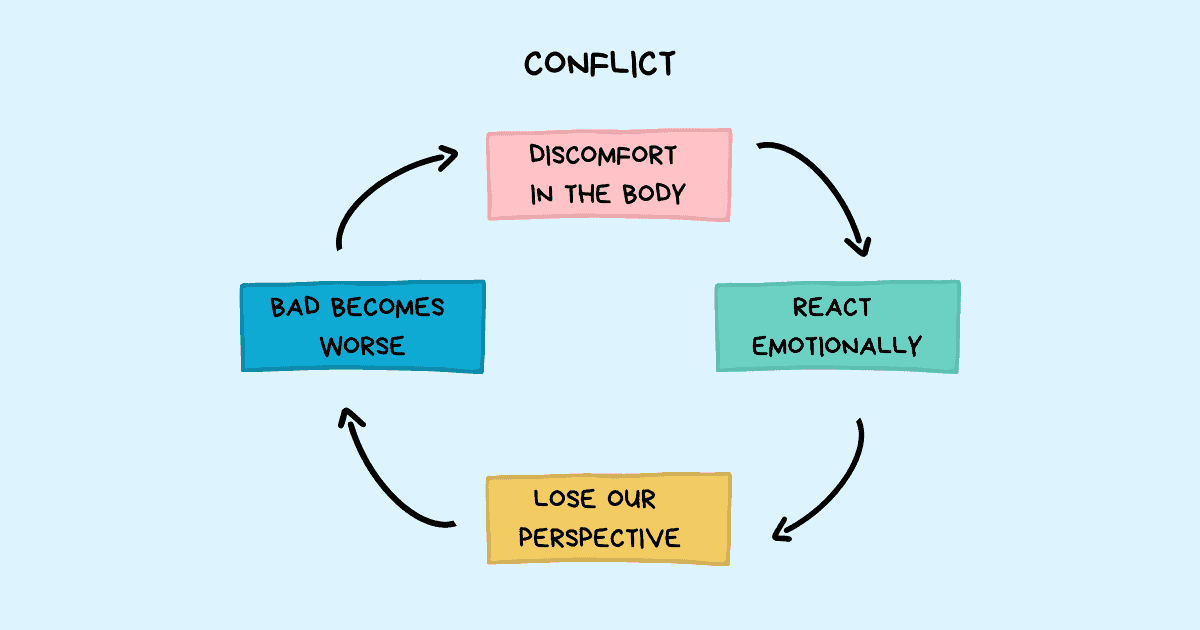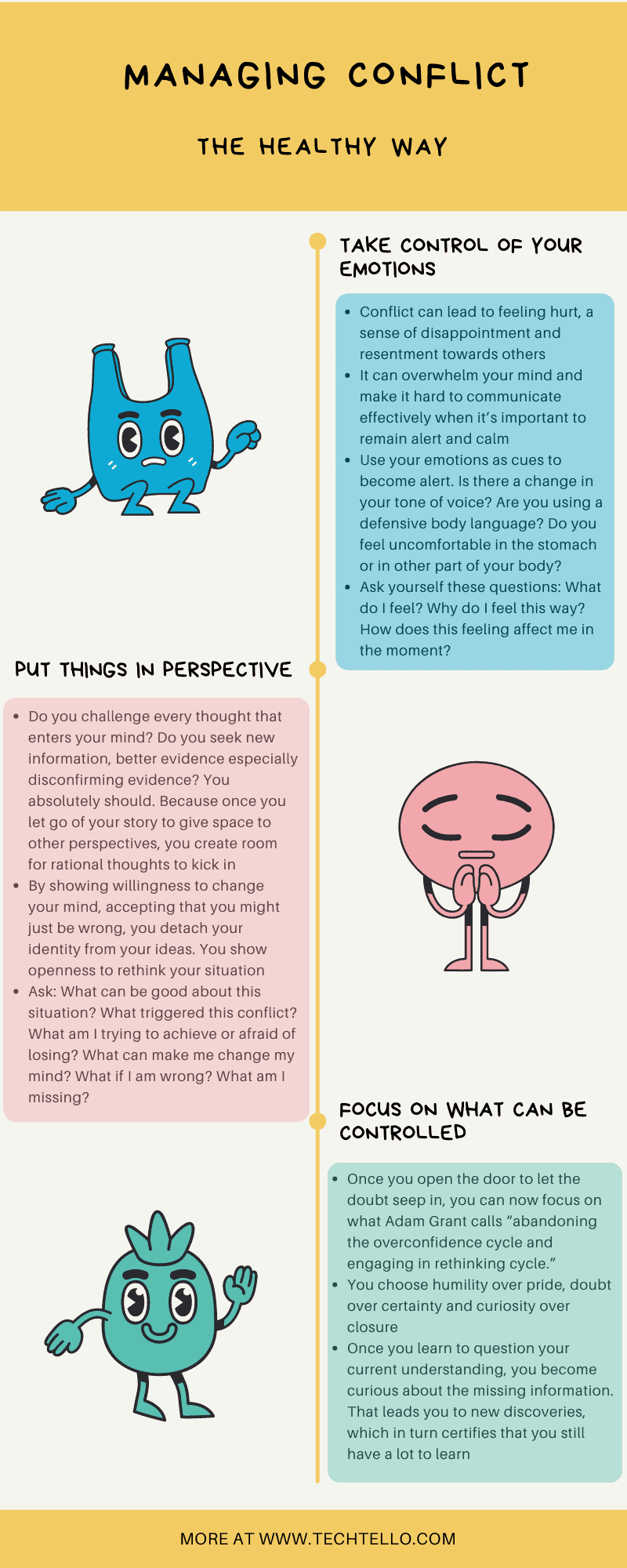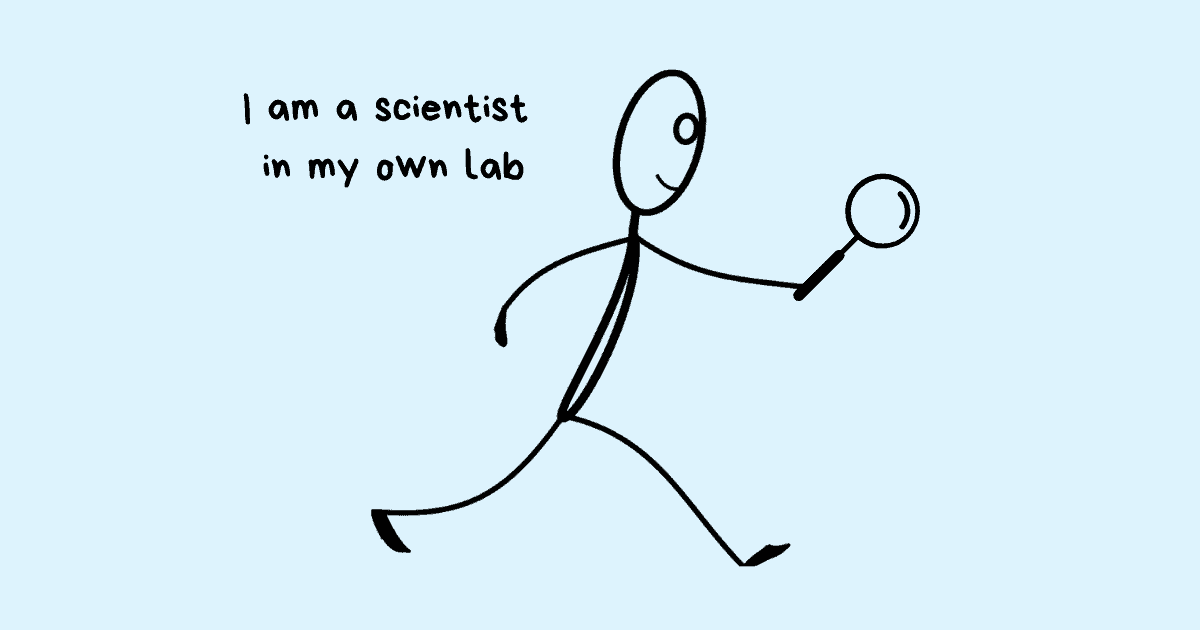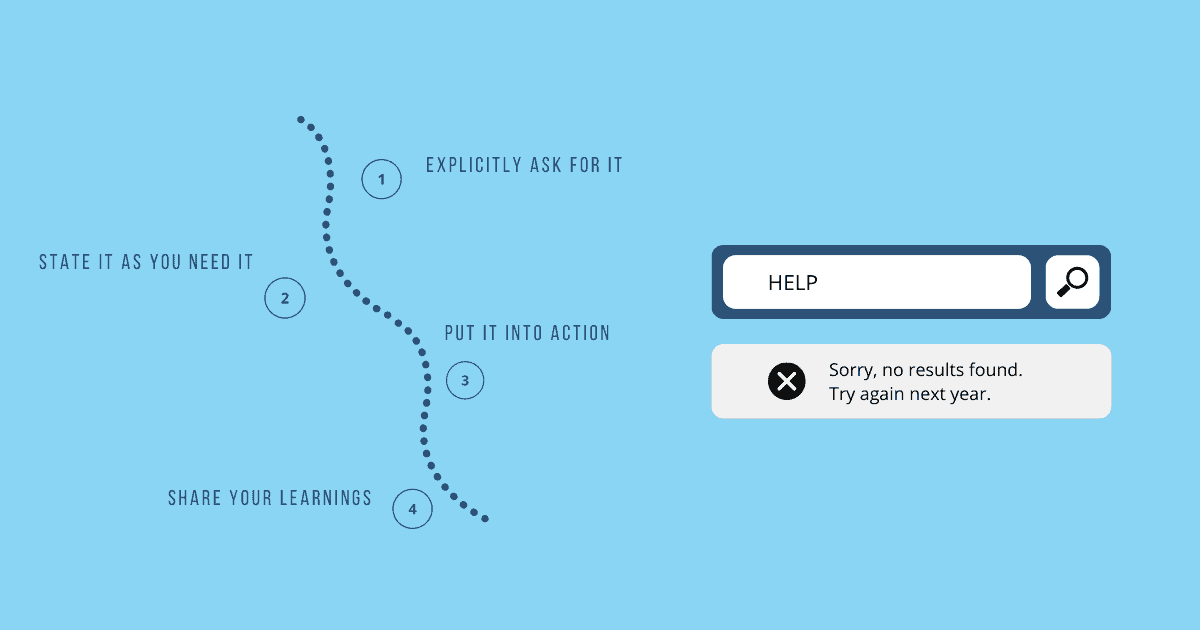Managing Conflict: Abandon Overconfidence And Engage In Rethinking Cycle

An argument with a coworker – conflict of opinion. Working on a project that doesn’t energize you – conflict of interest. Didn’t get the promotion – conflict of growth. Working super hard with no time for personal life – internal conflict. Saying yes to work that doesn’t align with your goals – conflict of priorities. Committed a mistake, but can’t come to terms with accepting responsibility – conflict of values. We don’t realize it, but most interactions at work lead to a major or minor conflict.
When it’s a minor conflict, we feel a sense of discomfort in our body but can’t pinpoint to the exact source of the discomfort. Most of the time we ignore this conflict while it sits within our subconscious as we go on with our daily life. A major conflict, though, looks and feels very different. Even though there’s no real danger, our mind perceives the conflict as a threat.
Shaped by evolution to protect ourselves from the threats in our environment, the response is almost automatic and unconscious. We feel the pressure building up inside our body – rapid breathing, increased heart beat, sweaty palms, sensation of tightening in the neck and jaw. Our safety is not at risk here, though it certainly feels that way. It’s the result of our fight-or-flight response triggered by the amygdala in our brain or as Daniel Goleman says in Emotional Intelligence, the perceived threat leads to “amygdala hijack.”
This fight-or-flight response is vital to our survival in other circumstances when there’s real danger – to escape a burning building or when a speeding car on a highway heads into our lane. Since our brain can’t differentiate between real and perceived threat, it sets off the alarm bells even when it’s just an emotional attack and in the process restricts access to the prefrontal cortex, which is the thinking part of our brain inhibiting purposeful action exactly when we need it the most.
We either try to fight the situation – becoming defensive and getting stuck with our perspective in a conversation “I’m right, you are wrong” or choose flight – try hard to suppress the emotion often wasting energy that’s best spent in some constructive action.
Conflict -> amygdala hijack -> restricted access to prefrontal cortex -> fight-or-flight response
What matters most in the moment is not the conflict, but how we react to it. As Ryan Holiday says in The Obstacle is the way “Too often we react emotionally, get despondent, and lose our perspective. All that does is turn bad things into really bad things. Unhelpful perceptions can invade our minds—that sacred place of reason, action and will—and throw off our compass.” He says that we have a choice in how we respond to the situation “We can be blindly led by these primal feelings or we can understand them and learn to filter them. Discipline in perception lets you clearly see the advantage and the proper course of action in every situation— without the pestilence of panic or fear.”
Managing conflict demands that we calm down and think clearly. Instead of letting our reaction slip through our unconscious, we need to take charge of it in conscious awareness. Instead of letting destructive patterns of behaviour be our default reaction, we can choose to engage in positive action. Seeing the conflict for what it is and not how it manifests at first.
Managing conflict, the healthy way
How we view a situation, changes everything. Doesn’t it? We can either view the conflict as a thing to be avoided or the source to get to the underlying truth. We can either let the negative feelings associated with a conflict obstruct our ability to think clearly or we can give way to positive feelings to forge a better path ahead. We can either let the conflict seem like an attack on our identity or learn to disconnect our ideas from our identity and be open to explore alternative viewpoints.
In the moment, it may seem like others are foolish or stupid for not seeing your side of the story. But do you realize that they are probably feeling the same way too? Do you make an effort to understand why their thinking is different from yours? What makes them so confident about their argument? What if they are right and you are wrong?
Every conflict doesn’t need to end with an agreement. You are sometimes better off with a healthy disagreement. Practice open mindedness by exploring alternate viewpoints and give an opportunity to others to present the world as they see it. No judgments. No attachments. Only the desire to see gaps in your knowledge, humility to doubt your convictions and the confidence in your ability to turn seemingly every bad situation into an opportunity to learn.
Apply these 3 steps to manage conflict in a healthy way:
1. Take control of your emotions
Conflict is an emotional experience, no doubt. It can lead to feeling hurt, a sense of disappointment, resentment towards others, frustration from not being heard and anger from feeling ignored, mistreated or disrespected.
These painful emotions are so real that they can overwhelm your mind and make it hard to communicate effectively especially in moments when it’s important to remain alert and calm. Without conscious awareness, you can become defensive about your position. You may stop thinking clearly and start acting weird. You don’t see it, others do.
The good part is you can learn to take charge of your emotions. Despite feeling these emotions, you can act in constructive ways. You can communicate without feeling threatened or intimidating others. What you need is emotional awareness – the ability to stay present without controlling or suppressing the sensations in your body.
Use your emotions as cues to become alert. Is there a change in your tone of voice? Are you using a defensive body language? Do you feel uncomfortable in the stomach or tension in any other part of your body?
Now, ask yourself these questions:
- What do I feel – anger, sadness, disgust, fear…
- Why do I feel this way?
- Am I dealing with a conflict?
- How does this feeling affect me in the moment?
You are not trying to resolve the conflict yet, but simply acknowledging its presence. And by doing so, you can come in touch with your real emotions. As Brene Brown says in Rising Strong “The opposite of recognizing that we’re feeling something is denying our emotions. The opposite of being curious is disengaging. When we deny our stories and disengage from tough emotions, they don’t go away; instead, they own us, they define us. Our job is not to deny the story, but to defy the ending—to rise strong, recognize our story, and rumble with the truth until we get to a place where we think, Yes. This is what happened. This is my truth. And I will choose how this story ends.”
With a willingness to face your emotions, you can now challenge them instead of internalizing and believing everything they are trying to convey. Not disregarding what you are feeling, but simply questioning whether you are feeling the right thing.
Take a few deep breaths to calm yourself down and move on to step two.
Master Difficult Conversations
Engage in healthy dialogue, build stronger relationships and achieve a better outcome.
2. Put things in perspective
There’s the conflict itself and then there’s a story we tell ourselves about it. When a coworker disagrees with you on a major decision, you may consider their disagreement as a sign of disrespect. When your boss refuses a promotion, you may think they are biased. When a teammate refuses to help out, you might call them insensitive and arrogant. But how do you know these stories are true or simply a creation of your mind?
Do you challenge every thought that enters your mind? Do you seek new information, better evidence especially disconfirming evidence? You absolutely should. Because once you let go of your story to give space to other perspectives, you create room for rational thoughts to kick in.
Negative emotions and negative thoughts keep you in a charged up state, lock you with a single minded focus on making others see your way and keep you away from recognizing when your opinions are off the mark.
By showing willingness to change your mind, accepting that you might just be wrong, you detach your identity from your ideas. You show openness to rethink your situation and that gives you permission to flip the negative reaction with a more positive thought. Now you can try to stay objective by questioning yourself:
- What can be good about this situation?
- What triggered this conflict?
- What am I trying to achieve or afraid of losing?
- What can make me change my mind?
- What if I am wrong?
- What makes the other person think this way or what am I missing?
All these questions will calm your mind by enabling the shift from blaming others to seeking solutions. From reacting to acting with intent. From trying to be right to finding the right answers. From sticking to your point of view even if you are wrong to accepting vulnerability. From attaching with your ideas to finding joy in learning new information.
Now that you are aware of and respect differences of opinion, move on to step three.
3. Focus on what can be controlled
Once you open the door to let the doubt seep in, you can now focus on what Adam Grant calls in Think Again “abandoning the overconfidence cycle and engaging in rethinking cycle.” Because that’s the only thing under your control.
He explains. In an overconfidence cycle, your pride breeds conviction rather than doubt. You are focussed on changing other people’s minds while yours is set in stone. That makes you disregard every disconfirming piece of evidence and seek validation that reinforces your beliefs. In a rethinking cycle, you choose humility over pride, doubt over certainty and curiosity over closure. Once you learn to question your current understanding, you become curious about the missing information. That leads you to new discoveries, which in turn certifies that you still have a lot to learn.
With a learning mindset, you can automatically tune in to effective listening. Try to go beyond their words to their intent. Observe their body language for subtle hints. Listen without interruptions, without judgment, without any distractions. Ask questions. Seek clarifications. Show that you are willing to change your mind.
And just by doing that you can indirectly encourage others to abandon their overconfidence cycle and engage in rethinking cycle. This technique works because “When we point out that there are areas where we agree and acknowledge that they have some valid points, we model confident humility and encourage them to follow suit. When we support our argument with a small number of cohesive, compelling reasons, we encourage them to start doubting their own opinion. And when we ask genuine questions, we leave them intrigued to learn more. We don’t have to convince them that we’re right—we just need to open their minds to the possibility that they might be wrong. Their natural curiosity might do the rest,” writes Adam Grant.
Remember though, these steps may not work. Others might become confrontational or try to escalate the situation. You can’t control them. All you can do is rethink your position. Maybe it’s best to sidestep. Not every conflict needs resolution and not every conflict can be resolved.
Summary:
Follow these three steps to manage conflict in a healthy manner:
- Take control of your emotions: Don’t deny or disengage with your emotions. Recognize them, accept them and then guide them into constructive action instead of engaging in destructive behaviours.
- Put things in perspective: Show willingness to change your mind by challenging your thoughts, accepting that you might be wrong and detaching your ideas from your identity.
- Focus on what can be controlled: Abandon overconfidence cycle to engage in a rethinking cycle thereby encouraging others to follow suit.






























